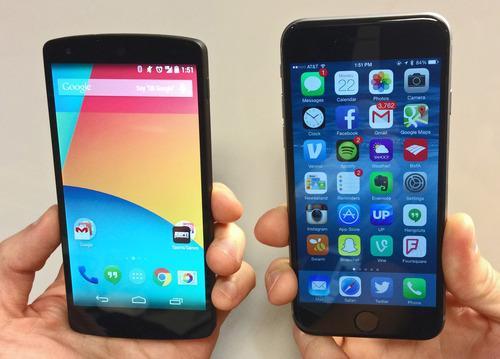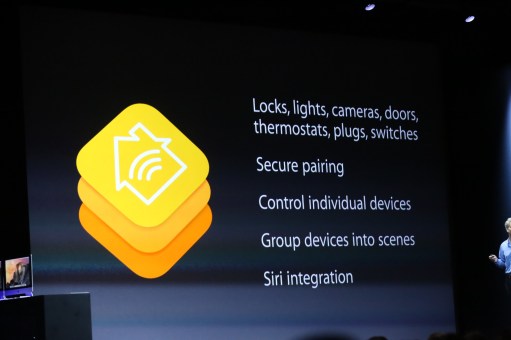
Now that Apple’s got its bigger, better iPhone 6 and 6 Plus, we suspect oodles of big-screen Android aficionados may defect to iOS. (Apparently Apple thinks so, too). But while switching phones is one type of headache, switching phones and operating systems can induce migraine-level pains if you’re not properly prepared.
But you will be prepared. From your can’t-miss calendar events to your favorite apps, here’s how to make sure your most important mobile needs make the transition from Android to iOS as smoothly as possible.
Mail, Calendar, and Contacts
If you keep your life synced with Google’s cloud-based ecosystem, transferring from Android to iOS is relatively easy. You’ll need to create an Apple ID when you first begin your iOS journey (if you don’t already have an iTunes account), but you can add your Google account once you’ve finished your phone’s initial setup.
More: 15 Insanely Great Tricks to Master Apple’s iOS 8
To do this, go to Settings → Mail, Contacts, Calendars, then tap Add Account. There you can add your Google account (or any other email account you’d like synced on the device). Once added, you can choose to sync Mail, Contacts, Calendars, and Notes.
If you’ve kept your contacts stored locally on your Android phone, you’ll first need to export your contacts to that device’s SD card, connect it to your computer and download the resulting .vcf file, and then log into your Google account. Click where it says Gmail in the upper left to go toContacts, then click the More tab and select Import. Now, when you add your Google account to your iPhone, your contacts will come along, too.
Keyboards
Since iOS 8 now supports third-party keyboards, the chances you’ll be able to continue using a near-identical version of your keyboard are extremely high. Lucky you!
Adding a third party keyboard to your system is pretty simple. Download the keyboard app from the App Store, and then go to Settings →General → Keyboards → Add New Keyboard. Navigate to the section for third-party keyboards, and you’ll see all the keyboard apps you’ve downloaded. Select the one you want to use, give it permission to be used systemwide, and you’re ready to go.
More: Amazon’s New Kindles Try to Replicate the Magic of Paper
Popular keyboards like SwiftKey, Swype, Fleksy, and TouchPal should now all be available for iOS 8.
Widgets
While you won’t have the same sort of home screen widgets as on an Android handset, iOS 8 does allow widgets in its Today view in the Notification Center. You access with a swipe down from the top of the screen and, as its name suggests, this is where you’ll also find a list of recent, actionable notifications you’ve received.
As for widgets, the latest version of the Yahoo Weather app includes one that acts like a miniature version of the full-blown app, with a location-specific Flickr photo annotated with current and future temperature conditions. Calendar apps like Readdle’s Calendars 5 also offer Notification Center widgets for a better glanceable version of your daily schedule than Apple’s Calendar provides.
Dropbox, Evernote, and OpenTable are some of the other titles that offer such widgets. 9to5Mac has a comprehensive alphabetical list of apps that currently enable Notification Center widgets, but more will surely be on the way.
Your app collection
Unfortunately, there’s no one- or two-step way to get all your favorites from Android onto your iOS device. You’ll need to go through and manually restock your homescreen with the apps you use on the regular.
But this annoyance is actually an opportunity in disguise. Now is the time to take an inventory of your app collection. Make a list of your actual favorites, the ones you use daily, and the ones you can’t imagine living without. Ditch the rest. Congratulations; your app collection just got a thorough fall cleaning.
More: These Swimmers Don’t Care What You Think About Their Crazy Swimsuits
With the exception of only a handful of titles (mostly games), nearly all of your Android favorites should also be on iOS. If you already shelled out big money for an Android version of an app, it could be worth dropping its customer service a line — it may be able to offer a discount code for your continued patronage, rather than risk you choosing a cheaper competing app. If the app is only $1, though, don’t be stingy; show the dev some love.
Photos, music, PDFs, and other media
One of the things I love about getting a new handset is the chance to start fresh. But some folks like to keep their favorite photos, videos, and music on their device, always. No sweat. If that’s you, you’ll want to first download them onto your computer (connect your Android device and then sync using Outlook or Exchange) and transfer them onto your iPhone via iTunes. To do this, connect your iPhone via USB or over WiFi and launch iTunes, click Sync with Phone , and then choose the media you want on your new phone (you can select from books, movies and TV shows, notes, photos, audio content, and more).
If you’re transferring PDFs and ePub documents, you can still access them on iOS using iBooks to read them (or another PDF reader). If you’ve got Office documents, then Apple’s Pages, Numbers, and Keynote will let you read and edit them on the iPhone, or you can use Microsoft Office for iOS.
Your MP3 files, if you aren’t already an avid Spotify or Rdio user, will live in Apple’s Music app on iOS once they’ve been added to iTunes. And once your audio collection is sorted, if you want to buy more music on the go, you’ll be buying content on iTunes (same goes for movies or TV shows).
For anything stored in the cloud — for instance on Evernote, Google Drive, or Dropbox — you’re good to go. Just download the iOS versions of those apps, and you’ll be able to access your files once they’re synced.







